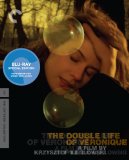| Reviews & Columns |
|
Reviews DVD TV on DVD Blu-ray 4K UHD International DVDs In Theaters Reviews by Studio Video Games Features Collector Series DVDs Easter Egg Database Interviews DVD Talk Radio Feature Articles Columns Anime Talk DVD Savant Horror DVDs The M.O.D. Squad Art House HD Talk Silent DVD
|
DVD Talk Forum |
|
|
| Resources |
|
DVD Price Search Customer Service #'s RCE Info Links |
|
Columns
|
|
|
Double Life of Veronique: The Criterion Collection, The
The Criterion Collection // R // February 1, 2011
List Price: $39.95 [Buy now and save at Amazon]
The Film:
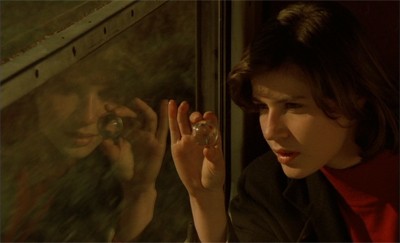 It's not that far-fetched to consider the existence of alternate realities. People regularly sketch them out in their minds; they contemplate what would've happened if they had lived in a different city or taken another job, and what might've come of asking that guy or girl in a coffee shop for their phone number. This idea sprouts a root structure of secondary curiosities, like whether they'd be a smoker in another setting or if their taste in music would've been the same. Krzysztof Kieslowski's The Double Life of Veronique (La Double vie de Véronique) not only acknowledges this idea of slightly-tweaked existences, but also perceptively -- and with a painterly, figurative eye -- outlines how a unique girl differs between two versions of the same life, shaped by her surroundings and decisions. But dropping them both in the same reality, and giving then a mysterious awareness of one another, changes this focus into something ethereal and introspective.
It's not that far-fetched to consider the existence of alternate realities. People regularly sketch them out in their minds; they contemplate what would've happened if they had lived in a different city or taken another job, and what might've come of asking that guy or girl in a coffee shop for their phone number. This idea sprouts a root structure of secondary curiosities, like whether they'd be a smoker in another setting or if their taste in music would've been the same. Krzysztof Kieslowski's The Double Life of Veronique (La Double vie de Véronique) not only acknowledges this idea of slightly-tweaked existences, but also perceptively -- and with a painterly, figurative eye -- outlines how a unique girl differs between two versions of the same life, shaped by her surroundings and decisions. But dropping them both in the same reality, and giving then a mysterious awareness of one another, changes this focus into something ethereal and introspective.
The Double Life of Veronique follows these two women born the same day whom suffer the same ailments, both played by Irène Jacob. It starts in Poland, where Weronika pursues a career as a virtuoso classical singer. She's vibrant and capricious, the kind of girl who'll sing in bucketing rainfall and feel nothing but joy, and she's also the type who won't ignore an unclear emotional pull to discover why she doesn't feel "alone in the world". Then, the film transports to France, where Veronique lives a quieter and more reserved life; she also gravitates towards music, yet she teaches young children's orchestral classes instead of pursuing a performing career. She's different in the way she wears her hair, carries herself, and even makes love, yet it's impossible not to see their deep-rooted similarities. She also feels an unexplained rush of emotion, though it's made of a darker, more unsettling fabric than Weronika's -- and only we know why.
Watching the dissimilarities and parallels between Weronika and Veronique becomes a mesmerizing experience that inspects the nature of identity, provoking our impulse to interpret the obscurity surrounding their search for answers. Kieslowski focuses on behavioral ticks, showing the similarities and differences between the women while a splendid Irène Jacob cradles necessary nuance in every move she makes. We spend a lot of time analyzing the gradient of her personas' facial mannerisms, from the glee one exudes during her rainfall serenade to the solemn curiosity that wafts over another as she watches a marionette performance. She's captivating, in every sense of the word. Her capacity to essentially create three different characters -- the core of Weronika/Veronique, and the individual components that make each of the two unique -- never lets our attention wander, unless Kieslowski intentionally wants it to. He does, occasionally, but only with intent.
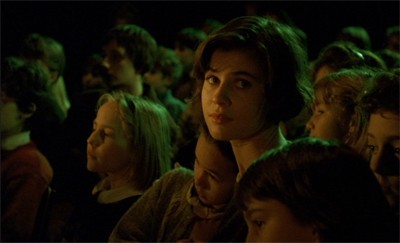 The yellowish-green haze that cinematographer Slawomir Idziak paints over The Double Life of Veronique gives it an otherworldly, meditative feel, which lulls those watching into a dream-like state. As shots linger on Kieslowski's doppelgangers, the director intercuts visuals meant to both obfuscate and guide our thoughts, such as shots of a glass ball rendering an upside-down image of a town passing before Weronika's eyes. Though the beauty seen within becomes enough of a reason to glance through the ball with her, it also triggers thoughts of glimpsing into an opposite version of her world, tying back to the film's musings. Instead of explaining their dual existence purely through words, he communicates their connection -- and, in tandem, their emotional isolation -- through lyrical eye-candy that, even without a deeper meaning, can leave one entranced at its beauty.
The yellowish-green haze that cinematographer Slawomir Idziak paints over The Double Life of Veronique gives it an otherworldly, meditative feel, which lulls those watching into a dream-like state. As shots linger on Kieslowski's doppelgangers, the director intercuts visuals meant to both obfuscate and guide our thoughts, such as shots of a glass ball rendering an upside-down image of a town passing before Weronika's eyes. Though the beauty seen within becomes enough of a reason to glance through the ball with her, it also triggers thoughts of glimpsing into an opposite version of her world, tying back to the film's musings. Instead of explaining their dual existence purely through words, he communicates their connection -- and, in tandem, their emotional isolation -- through lyrical eye-candy that, even without a deeper meaning, can leave one entranced at its beauty.
Perhaps the pinnacle of its thoughtful presence comes in an almost Hamlet-like "play within a play": the marionette show, right at the heart of the film's transitioning focus. It's a stunning sequence; with familiar green tones draped over an audience of children, and with that familiar music once again streaming through the air, an accomplished puppeteer reenacts the life of one of the doppelgangers in the presence of another, in the form of a ballerina. She's unaware, and in fact she becomes more interested in the person actually pulling the strings than the production he's putting on -- which is a shame, since he's answering many of the profound questions that trouble her. This sequence pulls together everything Kieslowski wants to communicate to its audience, yet he does so in a delicate way that's void of self-gratifying imagery, and it radiates a haunting sort of beauty because of that freedom.
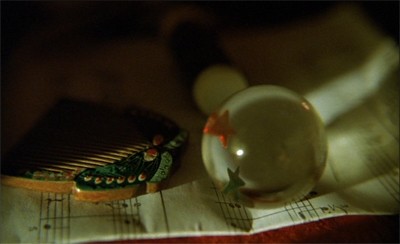 Kieslowski's choice to create an ambiguous link between these coexisting doppelgangers allows existential examination to propel The Double Life of Veronique, vaguely yet poignantly mining the ideas of kindred spirits and our control (or lack thereof) over individuality. That link Weronika and Veronique share, both the country-crossing flutters of emotion and their mutual drive towards music, offers a glimpse into the power of a deeper connection between human beings that reflects on predestination, while transforming into something of an emotional Rubik's Cube. Each churning of emotion that changes their lives -- from the dreams they share to their connected instances of unexplainable joy or depression -- reveals more of the enigma scattered across this deeply-felt story, yet Kieslowski's filmmaking here isn't about solving a riddle, nor does it demand finite answers to its inquiries of circumstance or correlation.
Kieslowski's choice to create an ambiguous link between these coexisting doppelgangers allows existential examination to propel The Double Life of Veronique, vaguely yet poignantly mining the ideas of kindred spirits and our control (or lack thereof) over individuality. That link Weronika and Veronique share, both the country-crossing flutters of emotion and their mutual drive towards music, offers a glimpse into the power of a deeper connection between human beings that reflects on predestination, while transforming into something of an emotional Rubik's Cube. Each churning of emotion that changes their lives -- from the dreams they share to their connected instances of unexplainable joy or depression -- reveals more of the enigma scattered across this deeply-felt story, yet Kieslowski's filmmaking here isn't about solving a riddle, nor does it demand finite answers to its inquiries of circumstance or correlation.
Instead, The Double Life of Veronique allows the soulful movement of its mystery to sweep our minds into blissful contemplation. When Kieslowski repurposes motifs throughout the film, it's not just so that the audience can make heads or tails of a defined mystery. The elements folded within the plot -- looking through glass balls, the recurring musical interlude, and the play-within-a-play -- all carry an emotional weight that takes them beyond mere clues leading to an end. They're reflections, artifacts tying to a deeper level of spellbound meditation on its purposes, doubling as guides towards comprehension and remnants of each doppelganger's existence. But the answers to what they signify matter little in the grander scheme; Kieslowski's more concerned with leaving an impression and stirring up feeling in these separate lives, replacing a need to overtly explain why they exist. They could be twins, doppelgangers, live in alternate realities or even embody metaphorical representations of their countries of origin, and it wouldn't change the emotive weight embedded in its spellbinding nature.
The Blu-ray:
The Criterion Collection have continued their selective upgrades to high-definition with this Blu-ray release of The Double Life of Veronique, spine #359, which comes in the company's customary clear plastic case. The disc artwork replicates that of the first disc from the standard-definition release, while the inlay artwork represents the split/mirror face design from the DVD set's inner foldout packaging (though it plays much better as separate sides of a foldout). A thick Booklet comes equipped with several of the textual materials from the original release, which includes the essay "Through the Looking Glass" by Jonathan Romney and the "Pure Emotions" excerpt from the 1993 publication, Kieslowski on Kieslowski. To create a more form-fitting book, two of the essays have been omitted for space constraints: "Kieslowski's Muse" by Peter Cowie, and "The Forced Choice of Freedom" by Slavoj ŽiŽek, though both links provided take you to their in-tact publication on Criterion's website.
Video and Audio:
Criterion's 1.66:1 transfer, a 1080p AVC encode stricken from a 35mm scan at 2K resolution, marks the second time that Krzysztof Kieslowski's film has been brought to the Blu-ray spectrum. Artificial Eye released a region-free edition roughly a year prior (which was available for comparison's sake), and the two share many similarities in their presentation of Slawomir Idziak's cinematography. Stylish yellow-and-green hues dominate the print with tempered reds inking through periodically, which both editions encompassed in an appropriately hazy, hypnotic luminance. Fine details only peek out on a periodic basis, such as the twines of Irène Jacob's hair and the refraction of light and images in the glass/rubber balls, while the natural film progression lends a lot of the overall flow of Kieslowski's emotional movement. Criterion's Blu-ray takes a few strides ahead by preserving more of the grain structure and erring towards less-dominant contrast, making the overall appearance texturally cinematic -- and a stunning presentation of its entrancing visual keel.
Audio sweeps in with a DTS HD Master Audio track that's relegated to the film's original two-channel design, pulled from the original magnetic tracks into a 24-bit mastering. As radiant and crisp as Criterion's original Dolby Digital track could be, this high-definition aural experience easily stands head-'n-shoulders above. The sound of Irène Jacob's soprano vocals are astoundingly clear, hitting the right pitches with no hint of distortion or strain, while the stream of dialogue pours through in both languages to the utmost capabilities of the format. Equally as important as these scenes, however, is Slawomir Idziak's supremely moody scoring, which hits both the forceful moments and the quieter, eerie flute fluttering to stunning effect. The sharp/flat sounds of a children's chorale all sound natural as they echo in the instruction room, while the quieter moments showcase immense awareness of atmospheric silence. As per Criterion's modus operandi, only English subtitles have been offered here.
Special Features:
Audio Commentary with Author Annette Insdorf:
Kieslowski expert Insdorf, who authored "Double Lives, Second Chances: The Cinema of Krzysztof Kieslowski", offers her expertise and perception of the filmmaker's technique with an in-depth and analytical track. She references the visual motifs and the music's storytelling in her dialogue with us, reflecting on the moments with the rubber ball, Weronika awakening from her dream, and the presence of "mirrored" items throughout the film, while also discussing alternate titles that Kieslowski considered. She poses questions to the audience, such as why Veronique turns on a light during lovemaking, then she offers her more-than-cogent interpretations of these elements. This commentary doesn't do the answering of questions that one might fear it does; instead, Insdorf does a tremendous job of addressing the questions without forcing her own analyses on the audience.
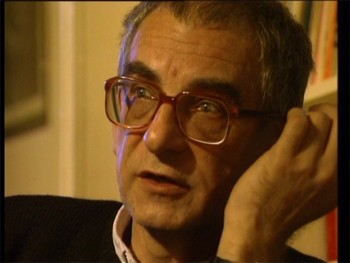 Kieslowski -- Dialogue (52:43, 4x3; HD AVC):
Kieslowski -- Dialogue (52:43, 4x3; HD AVC):
This near feature-length documentary on the making of The Double Life of Veronique takes us behind the camera with the late Kieslowski, through interviews and behind-the-scenes footage. He discusses the "universal quality" of the things he can film in Poland, why he uses the analogy of a "toothache" when describing the connection that Weronika and Veronique share, and the intimacy of the script-writing process. Lengthy expanses of footage from the film intercut with the smoke-filled interviews and raw off-screen footage. It's a good mix of reflection from the director and watching the process of the film coming together in his hands.
1966-1988: Kieslowski, Polish Filmmaker (30:39, 16x9; HD AVC):
This 2005 documentary, assembled by MK2 and directed by Luc Lagier, explores how the conditions in the filmmaker's homeland shaped him into the director that he'd become. It goes to extensive (well, somewhat extensive for a cinema-centered doc) detail in describing the constraints of the Polish filmmaking conditions, then shifts over into a more standard portrait of Kieslowski's history and body of work. Footage of several of his production show up in the piece, along with a lot of static photographs adorned with narration. Chapter stops are available for each of the piece's segments.
Interview with Slawomir Idziak (24:18, 16x9; HD AVC)
Kieslowski's cinematographer delves into his working relationship with the director in this exclusive interview with The Criterion Collection, outlining the conditions that the pair shot in. He reveals that Kieslowski one felt that the world of feature films was full of "artifice and deception", which caused him to veer towards documentaries, and the process in discovering Irène Jacob (as well as how he showed her test footage to a group of his peers, for something of a gauge of interest). The most intriguing part of the whole discussion comes in how Kieslowski and Idziak milled over how to create two near-identical landscapes in both Krakow and France, as well as decisions over the film's color scheme. He talks about his own custom filters, avoiding color, and how he felt "betrayed" at one point in the creative process. It's a great interview, anecdotal but very aware of the level of interest that the audience has with the cinematographer's angle.
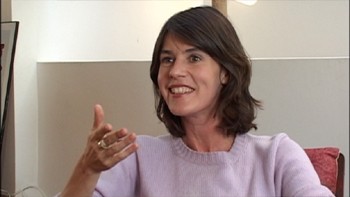 Inteview with Zbigniew Preisner (21:16, 16x9; HD AVC):
Inteview with Zbigniew Preisner (21:16, 16x9; HD AVC):
Preisner follows through his career with the late director in this exclusive interview, also exclusive to The Criterion Collection. He starts by revealing his affection for Kieslowski as both a director and a unique man, then moves over into his discussion about composing scores for his documentaries when we was in his late-20s. He then brings the attention to his philosophies on the pertinence of music to a film, as well as some of the components behind their work together on The Double Life of Veronique.
Interview with Irène Jacob (16:44, 16x9; HD AVC):
The third interview of the lot, this 2005-recorded interview follows how the luminous actress crossed paths with Kieslowski. She continues to explain her interview with him, her initial impressions on the ambiguous screenplay, and her additions to the fabric of Weronika/Veronique's character -- such as an anecdote about shoelaces. She also joyfully reflects on her days shooting the film, a few of her reflections on the film's context, and how there was very little room for deviating from the script. It's nearly seventeen (17) minutes of consistent interview time with very little breaks, and she offers perceptive and warmly impressive reflections on her place in the film.
The Criterion Collection have also carried over the four short-subject pieces of Kieslowski from the 2006 DVD -- The Musicians (1958), Factory (1970), Hospital (1976), and Railway Station (1980) -- as well as the Harvey Weinstein-driven U.S. Ending (5:17 4x3; HD AVC) that, really, adds a needless bit of sentiment at the end of a supremely elegant picture. For the curious, no new features have been constructed specifically for this release.
Final Thoughts:
Every viewing of The Double Life of Veronique enriches one's appreciation of the beauty, mystique, and profound depth residing within Krzysztof Kieslowski's construction. It's a picture that pivots on its obscurity, finding rich context in its ability to focus more on a capacity to feel than a compulsion to offer answers. When Kieslowski wraps us in the complex emotional framework of the connected lives of doppelgangers Weronika and Veronique, he gracefully makes every detail feel pertinent -- not as a hint, but as an added prod towards understanding what their connection actually entails on a deeper level. And, of course, Irène Jacob's radiant performance only becomes more involving with time, revealing more reflexive grace and haunting beauty with each glimpse we get of her duplicity. A lot of complex deeply-felt material stirs in the film, but it never loses its focus or treads into abstract pretense with its context. The Criterion Collection's Blu-ray certainly merits the upgrade, presenting the stylized yellow-filtered cinematography in the most natural feel it's seen to-date. An absolute no-brainer for those who don't already own this terrific piece of work, and a feature-packed version for those wishing to move up to Kieslowski in HD. DVDTalk Collector's Series.
Note: Screenshots in this review are from Criterion's 2006 DVD presentation, and do not represent the quality of the Blu-ray reviewed here.
Thomas Spurlin, Staff Reviewer -- DVDTalk Reviews | Personal Blog/Site
 It's not that far-fetched to consider the existence of alternate realities. People regularly sketch them out in their minds; they contemplate what would've happened if they had lived in a different city or taken another job, and what might've come of asking that guy or girl in a coffee shop for their phone number. This idea sprouts a root structure of secondary curiosities, like whether they'd be a smoker in another setting or if their taste in music would've been the same. Krzysztof Kieslowski's The Double Life of Veronique (La Double vie de Véronique) not only acknowledges this idea of slightly-tweaked existences, but also perceptively -- and with a painterly, figurative eye -- outlines how a unique girl differs between two versions of the same life, shaped by her surroundings and decisions. But dropping them both in the same reality, and giving then a mysterious awareness of one another, changes this focus into something ethereal and introspective.
It's not that far-fetched to consider the existence of alternate realities. People regularly sketch them out in their minds; they contemplate what would've happened if they had lived in a different city or taken another job, and what might've come of asking that guy or girl in a coffee shop for their phone number. This idea sprouts a root structure of secondary curiosities, like whether they'd be a smoker in another setting or if their taste in music would've been the same. Krzysztof Kieslowski's The Double Life of Veronique (La Double vie de Véronique) not only acknowledges this idea of slightly-tweaked existences, but also perceptively -- and with a painterly, figurative eye -- outlines how a unique girl differs between two versions of the same life, shaped by her surroundings and decisions. But dropping them both in the same reality, and giving then a mysterious awareness of one another, changes this focus into something ethereal and introspective. The Double Life of Veronique follows these two women born the same day whom suffer the same ailments, both played by Irène Jacob. It starts in Poland, where Weronika pursues a career as a virtuoso classical singer. She's vibrant and capricious, the kind of girl who'll sing in bucketing rainfall and feel nothing but joy, and she's also the type who won't ignore an unclear emotional pull to discover why she doesn't feel "alone in the world". Then, the film transports to France, where Veronique lives a quieter and more reserved life; she also gravitates towards music, yet she teaches young children's orchestral classes instead of pursuing a performing career. She's different in the way she wears her hair, carries herself, and even makes love, yet it's impossible not to see their deep-rooted similarities. She also feels an unexplained rush of emotion, though it's made of a darker, more unsettling fabric than Weronika's -- and only we know why.
Watching the dissimilarities and parallels between Weronika and Veronique becomes a mesmerizing experience that inspects the nature of identity, provoking our impulse to interpret the obscurity surrounding their search for answers. Kieslowski focuses on behavioral ticks, showing the similarities and differences between the women while a splendid Irène Jacob cradles necessary nuance in every move she makes. We spend a lot of time analyzing the gradient of her personas' facial mannerisms, from the glee one exudes during her rainfall serenade to the solemn curiosity that wafts over another as she watches a marionette performance. She's captivating, in every sense of the word. Her capacity to essentially create three different characters -- the core of Weronika/Veronique, and the individual components that make each of the two unique -- never lets our attention wander, unless Kieslowski intentionally wants it to. He does, occasionally, but only with intent.
 The yellowish-green haze that cinematographer Slawomir Idziak paints over The Double Life of Veronique gives it an otherworldly, meditative feel, which lulls those watching into a dream-like state. As shots linger on Kieslowski's doppelgangers, the director intercuts visuals meant to both obfuscate and guide our thoughts, such as shots of a glass ball rendering an upside-down image of a town passing before Weronika's eyes. Though the beauty seen within becomes enough of a reason to glance through the ball with her, it also triggers thoughts of glimpsing into an opposite version of her world, tying back to the film's musings. Instead of explaining their dual existence purely through words, he communicates their connection -- and, in tandem, their emotional isolation -- through lyrical eye-candy that, even without a deeper meaning, can leave one entranced at its beauty.
The yellowish-green haze that cinematographer Slawomir Idziak paints over The Double Life of Veronique gives it an otherworldly, meditative feel, which lulls those watching into a dream-like state. As shots linger on Kieslowski's doppelgangers, the director intercuts visuals meant to both obfuscate and guide our thoughts, such as shots of a glass ball rendering an upside-down image of a town passing before Weronika's eyes. Though the beauty seen within becomes enough of a reason to glance through the ball with her, it also triggers thoughts of glimpsing into an opposite version of her world, tying back to the film's musings. Instead of explaining their dual existence purely through words, he communicates their connection -- and, in tandem, their emotional isolation -- through lyrical eye-candy that, even without a deeper meaning, can leave one entranced at its beauty. Perhaps the pinnacle of its thoughtful presence comes in an almost Hamlet-like "play within a play": the marionette show, right at the heart of the film's transitioning focus. It's a stunning sequence; with familiar green tones draped over an audience of children, and with that familiar music once again streaming through the air, an accomplished puppeteer reenacts the life of one of the doppelgangers in the presence of another, in the form of a ballerina. She's unaware, and in fact she becomes more interested in the person actually pulling the strings than the production he's putting on -- which is a shame, since he's answering many of the profound questions that trouble her. This sequence pulls together everything Kieslowski wants to communicate to its audience, yet he does so in a delicate way that's void of self-gratifying imagery, and it radiates a haunting sort of beauty because of that freedom.
 Kieslowski's choice to create an ambiguous link between these coexisting doppelgangers allows existential examination to propel The Double Life of Veronique, vaguely yet poignantly mining the ideas of kindred spirits and our control (or lack thereof) over individuality. That link Weronika and Veronique share, both the country-crossing flutters of emotion and their mutual drive towards music, offers a glimpse into the power of a deeper connection between human beings that reflects on predestination, while transforming into something of an emotional Rubik's Cube. Each churning of emotion that changes their lives -- from the dreams they share to their connected instances of unexplainable joy or depression -- reveals more of the enigma scattered across this deeply-felt story, yet Kieslowski's filmmaking here isn't about solving a riddle, nor does it demand finite answers to its inquiries of circumstance or correlation.
Kieslowski's choice to create an ambiguous link between these coexisting doppelgangers allows existential examination to propel The Double Life of Veronique, vaguely yet poignantly mining the ideas of kindred spirits and our control (or lack thereof) over individuality. That link Weronika and Veronique share, both the country-crossing flutters of emotion and their mutual drive towards music, offers a glimpse into the power of a deeper connection between human beings that reflects on predestination, while transforming into something of an emotional Rubik's Cube. Each churning of emotion that changes their lives -- from the dreams they share to their connected instances of unexplainable joy or depression -- reveals more of the enigma scattered across this deeply-felt story, yet Kieslowski's filmmaking here isn't about solving a riddle, nor does it demand finite answers to its inquiries of circumstance or correlation. Instead, The Double Life of Veronique allows the soulful movement of its mystery to sweep our minds into blissful contemplation. When Kieslowski repurposes motifs throughout the film, it's not just so that the audience can make heads or tails of a defined mystery. The elements folded within the plot -- looking through glass balls, the recurring musical interlude, and the play-within-a-play -- all carry an emotional weight that takes them beyond mere clues leading to an end. They're reflections, artifacts tying to a deeper level of spellbound meditation on its purposes, doubling as guides towards comprehension and remnants of each doppelganger's existence. But the answers to what they signify matter little in the grander scheme; Kieslowski's more concerned with leaving an impression and stirring up feeling in these separate lives, replacing a need to overtly explain why they exist. They could be twins, doppelgangers, live in alternate realities or even embody metaphorical representations of their countries of origin, and it wouldn't change the emotive weight embedded in its spellbinding nature.
The Blu-ray:
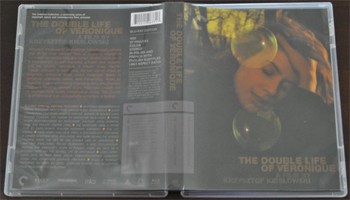 | 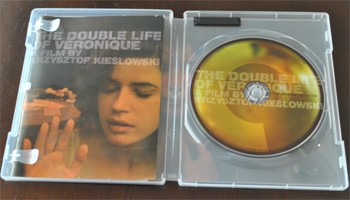 |
The Criterion Collection have continued their selective upgrades to high-definition with this Blu-ray release of The Double Life of Veronique, spine #359, which comes in the company's customary clear plastic case. The disc artwork replicates that of the first disc from the standard-definition release, while the inlay artwork represents the split/mirror face design from the DVD set's inner foldout packaging (though it plays much better as separate sides of a foldout). A thick Booklet comes equipped with several of the textual materials from the original release, which includes the essay "Through the Looking Glass" by Jonathan Romney and the "Pure Emotions" excerpt from the 1993 publication, Kieslowski on Kieslowski. To create a more form-fitting book, two of the essays have been omitted for space constraints: "Kieslowski's Muse" by Peter Cowie, and "The Forced Choice of Freedom" by Slavoj ŽiŽek, though both links provided take you to their in-tact publication on Criterion's website.
Video and Audio:
Criterion's 1.66:1 transfer, a 1080p AVC encode stricken from a 35mm scan at 2K resolution, marks the second time that Krzysztof Kieslowski's film has been brought to the Blu-ray spectrum. Artificial Eye released a region-free edition roughly a year prior (which was available for comparison's sake), and the two share many similarities in their presentation of Slawomir Idziak's cinematography. Stylish yellow-and-green hues dominate the print with tempered reds inking through periodically, which both editions encompassed in an appropriately hazy, hypnotic luminance. Fine details only peek out on a periodic basis, such as the twines of Irène Jacob's hair and the refraction of light and images in the glass/rubber balls, while the natural film progression lends a lot of the overall flow of Kieslowski's emotional movement. Criterion's Blu-ray takes a few strides ahead by preserving more of the grain structure and erring towards less-dominant contrast, making the overall appearance texturally cinematic -- and a stunning presentation of its entrancing visual keel.
Audio sweeps in with a DTS HD Master Audio track that's relegated to the film's original two-channel design, pulled from the original magnetic tracks into a 24-bit mastering. As radiant and crisp as Criterion's original Dolby Digital track could be, this high-definition aural experience easily stands head-'n-shoulders above. The sound of Irène Jacob's soprano vocals are astoundingly clear, hitting the right pitches with no hint of distortion or strain, while the stream of dialogue pours through in both languages to the utmost capabilities of the format. Equally as important as these scenes, however, is Slawomir Idziak's supremely moody scoring, which hits both the forceful moments and the quieter, eerie flute fluttering to stunning effect. The sharp/flat sounds of a children's chorale all sound natural as they echo in the instruction room, while the quieter moments showcase immense awareness of atmospheric silence. As per Criterion's modus operandi, only English subtitles have been offered here.
Special Features:
Audio Commentary with Author Annette Insdorf:
Kieslowski expert Insdorf, who authored "Double Lives, Second Chances: The Cinema of Krzysztof Kieslowski", offers her expertise and perception of the filmmaker's technique with an in-depth and analytical track. She references the visual motifs and the music's storytelling in her dialogue with us, reflecting on the moments with the rubber ball, Weronika awakening from her dream, and the presence of "mirrored" items throughout the film, while also discussing alternate titles that Kieslowski considered. She poses questions to the audience, such as why Veronique turns on a light during lovemaking, then she offers her more-than-cogent interpretations of these elements. This commentary doesn't do the answering of questions that one might fear it does; instead, Insdorf does a tremendous job of addressing the questions without forcing her own analyses on the audience.
 Kieslowski -- Dialogue (52:43, 4x3; HD AVC):
Kieslowski -- Dialogue (52:43, 4x3; HD AVC): This near feature-length documentary on the making of The Double Life of Veronique takes us behind the camera with the late Kieslowski, through interviews and behind-the-scenes footage. He discusses the "universal quality" of the things he can film in Poland, why he uses the analogy of a "toothache" when describing the connection that Weronika and Veronique share, and the intimacy of the script-writing process. Lengthy expanses of footage from the film intercut with the smoke-filled interviews and raw off-screen footage. It's a good mix of reflection from the director and watching the process of the film coming together in his hands.
1966-1988: Kieslowski, Polish Filmmaker (30:39, 16x9; HD AVC):
This 2005 documentary, assembled by MK2 and directed by Luc Lagier, explores how the conditions in the filmmaker's homeland shaped him into the director that he'd become. It goes to extensive (well, somewhat extensive for a cinema-centered doc) detail in describing the constraints of the Polish filmmaking conditions, then shifts over into a more standard portrait of Kieslowski's history and body of work. Footage of several of his production show up in the piece, along with a lot of static photographs adorned with narration. Chapter stops are available for each of the piece's segments.
Interview with Slawomir Idziak (24:18, 16x9; HD AVC)
Kieslowski's cinematographer delves into his working relationship with the director in this exclusive interview with The Criterion Collection, outlining the conditions that the pair shot in. He reveals that Kieslowski one felt that the world of feature films was full of "artifice and deception", which caused him to veer towards documentaries, and the process in discovering Irène Jacob (as well as how he showed her test footage to a group of his peers, for something of a gauge of interest). The most intriguing part of the whole discussion comes in how Kieslowski and Idziak milled over how to create two near-identical landscapes in both Krakow and France, as well as decisions over the film's color scheme. He talks about his own custom filters, avoiding color, and how he felt "betrayed" at one point in the creative process. It's a great interview, anecdotal but very aware of the level of interest that the audience has with the cinematographer's angle.
 Inteview with Zbigniew Preisner (21:16, 16x9; HD AVC):
Inteview with Zbigniew Preisner (21:16, 16x9; HD AVC): Preisner follows through his career with the late director in this exclusive interview, also exclusive to The Criterion Collection. He starts by revealing his affection for Kieslowski as both a director and a unique man, then moves over into his discussion about composing scores for his documentaries when we was in his late-20s. He then brings the attention to his philosophies on the pertinence of music to a film, as well as some of the components behind their work together on The Double Life of Veronique.
Interview with Irène Jacob (16:44, 16x9; HD AVC):
The third interview of the lot, this 2005-recorded interview follows how the luminous actress crossed paths with Kieslowski. She continues to explain her interview with him, her initial impressions on the ambiguous screenplay, and her additions to the fabric of Weronika/Veronique's character -- such as an anecdote about shoelaces. She also joyfully reflects on her days shooting the film, a few of her reflections on the film's context, and how there was very little room for deviating from the script. It's nearly seventeen (17) minutes of consistent interview time with very little breaks, and she offers perceptive and warmly impressive reflections on her place in the film.
The Criterion Collection have also carried over the four short-subject pieces of Kieslowski from the 2006 DVD -- The Musicians (1958), Factory (1970), Hospital (1976), and Railway Station (1980) -- as well as the Harvey Weinstein-driven U.S. Ending (5:17 4x3; HD AVC) that, really, adds a needless bit of sentiment at the end of a supremely elegant picture. For the curious, no new features have been constructed specifically for this release.
Final Thoughts:
Every viewing of The Double Life of Veronique enriches one's appreciation of the beauty, mystique, and profound depth residing within Krzysztof Kieslowski's construction. It's a picture that pivots on its obscurity, finding rich context in its ability to focus more on a capacity to feel than a compulsion to offer answers. When Kieslowski wraps us in the complex emotional framework of the connected lives of doppelgangers Weronika and Veronique, he gracefully makes every detail feel pertinent -- not as a hint, but as an added prod towards understanding what their connection actually entails on a deeper level. And, of course, Irène Jacob's radiant performance only becomes more involving with time, revealing more reflexive grace and haunting beauty with each glimpse we get of her duplicity. A lot of complex deeply-felt material stirs in the film, but it never loses its focus or treads into abstract pretense with its context. The Criterion Collection's Blu-ray certainly merits the upgrade, presenting the stylized yellow-filtered cinematography in the most natural feel it's seen to-date. An absolute no-brainer for those who don't already own this terrific piece of work, and a feature-packed version for those wishing to move up to Kieslowski in HD. DVDTalk Collector's Series.
Note: Screenshots in this review are from Criterion's 2006 DVD presentation, and do not represent the quality of the Blu-ray reviewed here.
|
| Popular Reviews |
| Sponsored Links |
|
|
| Sponsored Links |
|
|
| Release List | Reviews | Shop | Newsletter | Forum | DVD Giveaways | Blu-Ray | Advertise |
|
Copyright 2024 DVDTalk.com All Rights Reserved. Legal Info, Privacy Policy, Terms of Use,
Manage Preferences,
Your Privacy Choices | |||||||









